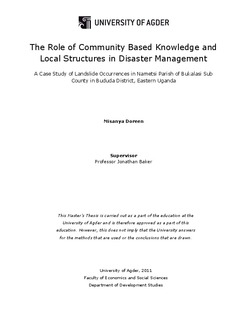| dc.description.abstract | All over the world, disasters are known to destroy developments which have taken years to be achieved in just a few hours or even minutes. Evidence in this study and in the literature investigated suggests that both developed countries like Japan and the USA, and developing countries like Haiti, Sri Lanka and Uganda have experienced disasters; the effects of which have been similar. By implication, disaster management does not only require finances but also adequate preparation involving all stakeholders. Specifically, stakeholders like community members must be well prepared and adequately equipped to cope with disasters.
This study explored the role of community based knowledge and local structures in disaster management and especially how these could be used for disaster management. This was premised on the thesis that when disasters occur, communities constitute key primary actors in relief provision and they do this on the basis of their knowledge through structures in their communities.
Qualitative methodologies were used in this study with the resonation that it would help gather community perceptions in relation to the causes and effects of the disasters and how these perceptions shape their knowledge, practices and general responses to the phenomenon.
Findings from the study revealed that explanations for causes of the disasters are as varied and diverse as there are responses to them. Whereas some community members acknowledged that their actions have contributed to disasters, others said that natural happenings like rainfall and volcanism triggered the landslide, while others maintained that there were evil and godly/ divine powers behind it all.
Whilst community based knowledge and local structures were found to be very significant at the various strands of disaster management, it was also found that they are not without limitations during their application as well as utilisation.
The study further revealed the loose synergy between government, civil societies and communities and therefore recommended cooperation, coproduction, and interdependence as key solutions
Different forms of community based knowledge and local structures in Nametsi Parish were established and the study suggested that these could be put to use by directly and actively involving communities, changing attitudes towards them, harnessing and documenting CBK and capacity building and empowering communities.
Key words: Community based knowledge (CBK), local structures, disaster, and disaster management (DM). | en_US |
